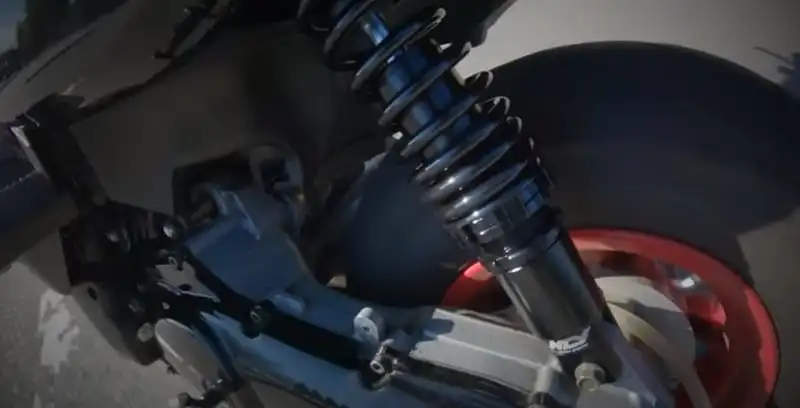It’s time to recalibrate your understanding of motorcycle tires. We’re often so engrossed in details about tire compounds and structural design, but this approach may overlook the most critical aspect of tires.
Many of us realize that tires are a crucial element of our motorcycles, something we can’t afford to compromise on.
This is because, unlike cars, poor or defective motorcycle tires can swiftly result in an accident. But have you ever considered that your tires also function as springs?
Tires as Springs
Indeed, the concept of tires as springs isn’t far-fetched. Let’s consider this scenario: if you strike a spring with a hammer, the force exerted on the spring bounces back, potentially hitting you in the face.
What about if you drop an inflated tire onto the ground? The tire rebounds like a spring, demonstrating Newton’s third law that every action has an equal and opposite reaction.
Springs come with specifications. For instance, a mountain bike shock spring has a 425 lb-inch rating, meaning it requires 425 lbs of force to compress it by one inch.
This concept is not much different from PSI or the pressure inside our tire. Increasing air pressure requires more force to compress the tire. However, the significant discrepancy between a shock and a tire lies in their damping rates.
The Importance of Correct Terminology: Damping Not Dampening
Now, let’s clarify a common misunderstanding, especially among casual motorcyclists. Words like sag, preload, compression damping, and rebound damping are often thrown around.
However, many erroneously refer to it as “dampening.” Let me save you from potential embarrassment; dampening refers to making something damp.
On the other hand, damping means reducing the oscillation’s amplitude. The correct term in suspension parlance is damping. Your damper is responsible for all the damping activities. Therefore, it’s damping, not dampening.
Damper Function and Tires
In the context of our motorcycles, the damper inside our suspension regulates the speed at which the forks compress and rebound after encountering a bump.
However, unlike our shocks, our tires are springs without any damping. You can technically dampen your tire, but that’s not what we aim for.
This understanding shifts our perspective significantly. Once we start viewing our tires as springs, we realize the potential problem with quick, abrupt, or fast inputs.
Consider a spring: if you compress it gradually, you have better control over its behavior than if you suddenly strike it with a hammer.
This principle applies to our tires. How do you think the tire will react if you apply the brake abruptly or swiftly countersteer?
The Principle of Load and Grip

Yamaha Champions Riding School popularized their “100 Points of Grip” concept, advocating “we load the tire before we work the tire.” To put it simply, grip stems from weight; patience is essential when waiting for the weight.
A tire can handle a remarkable amount of load, but what happens when you subject it to a sudden amount of load? Like a spring, it reacts by pushing back just as suddenly.
Strategies for Smooth, Linear Inputs
We can adopt several tactics to ensure we make smooth, linear inputs. The most vital one involves staying aware of our surroundings and our actions.
Simply looking ahead isn’t sufficient; reaction time comprises perception time (the duration required to identify a problem) and activation time (the time it takes us to react, such as applying the brakes).
We can reduce our perception time by staying focused and constantly scanning our surroundings. Detecting a hazard just one second earlier at highway speeds provides us with an additional 35 meters (or over 110 feet) to respond.
Moreover, keeping our hand on the front brake can decrease our activation time by 1 to 3 seconds, as per certain studies. Combine these time savings, and you gain nearly a football field’s length of additional space to tackle any arising issue.
The 5% Rule for Control Inputs
The next strategy entails concentrating on the initial and final 5% of every control input, i.e., the first and last 5% of squeezing.
In stressful scenarios, we usually fall back on our most practiced habits. That’s why here at Kings motorcycle gear, we strictly advocate techniques that are effective under all circumstances, not just ideal conditions.
One critical practice is the smooth, linear application of our inputs, particularly the first and last 5%.
To sum up, your tires are indeed springs. Don’t shy away from your controls or your front brake. Rather, be cautious of abruptness. Remember the sage advice of a young motorcycle racer: “We don’t want to surprise the tire.”
Key Takeaways:
- Tires function as springs and should be treated with smooth, controlled inputs.
- Understanding the difference between damping and dampening.
- Importance of practicing best riding practices.
- Reducing perception and activation time for enhanced safety.
- Emphasizing the initial and final 5% of control inputs.

